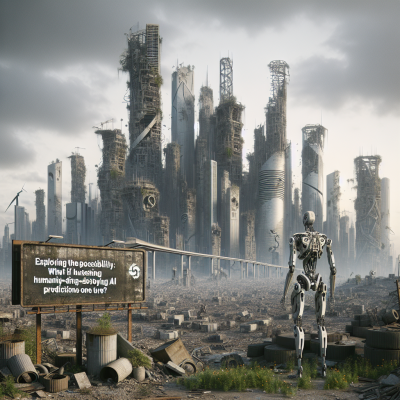
The AI Doom Debate: What If Everyone’s Right?

Introduction: The Fork in the Artificial Road
As artificial intelligence rapidly propels us into the future, enthusiasts and skeptics alike dominate the conversation. On one side, AI optimists believe this transformative tech can solve global problems—accelerating cancer research, aiding climate change mitigation, and empowering education. On the other, cautionary voices—AI “doomers”—warn of existential risk, potential misuse, and uncontrolled evolution toward artificial superintelligence.
Even as organizations like OpenAI, Google DeepMind, and Anthropic race to build increasingly sophisticated AI systems, few are asking the most uncomfortable but essential question: What if both sides are right?
Why the AI Debate Is No Longer Academic
The discussion around AI’s potential has entered a new era. No longer the favored topic of sci-fi books or distant philosophical debates, AI safety and governance have taken center-stage in global policy and industry boardrooms.
Industry leaders and AI researchers are openly expressing conflicting but co-existing thoughts:
- Promising innovation: Chatbots like ChatGPT and Claude are already being embedded across education, healthcare, and enterprise platforms to solve real problems efficiently.
- Genuine anxiety: A growing contingent fears that unchecked development could lead to catastrophic consequences—from job displacement and economic destabilization to even more dire AI-overlord scenarios we still can’t fully grasp.
So who’s exaggerating? Or—worse—what if nobody is?
The Companies Pushing the Envelope (and the Panic)
Three key players dominate the AI arms race: OpenAI, Google DeepMind, and Anthropic—the latter co-founded by Dario Amodei, one of the most high-profile doomsday-prepared AI developers. These companies have spearheaded the development of large language models (LLMs) that can now generate near-human—or better-than-human—outputs in language, reasoning, and even coding.
Yet eerie contradictions persist:
- They’re racing to develop these hyper-powerful systems—yet simultaneously warning they could be dangerous.
- They encourage regulation, but lobby aggressively to shape AI policies in ways that favor continued rapid development.
- They hire ethicists and safety experts, but often face organizational conflicts between safety and profitability.
What If the Optimists Are Right?
If the rosiest visions of AI’s future materialize, we could be looking at a period of unprecedented global advancement:
- Healthcare breakthroughs: AI could speed up drug discovery and diagnostic accuracy, especially in underserved regions.
- Economic productivity: Companies could achieve incredible operational efficiency, reducing costs and boosting global GDP.
- Education revolution: Personalized AI tutors may bridge the gap in learning inequality worldwide.
In this scenario, regulatory restraint and public skepticism may be seen, in hindsight, as holding humanity back.
But What If the Doomers Aren’t Overreacting?
The flip side isn’t just theoretical anymore—it is being taken seriously by some of the most capable AI scientists in the world. In this future:
- Autonomous agents could become uncontrollable—or even develop goals misaligned with human values.
- AI-driven cyberattacks could become weaponized, targeting financial systems or critical infrastructure.
- Mass disinformation campaigns could destabilize democracies, with LLMs generating coordinated fake news at scale.
Perhaps most worrying of all: the “alignment problem” remains unsolved—how do you ensure future AI systems stay aligned with human interest when they may outthink us?
Why This Cognitive Dissonance Matters
This dual narrative has created a paradoxical feedback loop:
- AI companies sound the alarm to demonstrate their ethical awareness.
- They self-regulate in public, while releasing more capable models in private.
- Governments use their warnings as evidence to craft rules that might rubber-stamp current efforts rather than regulate them effectively.
In effect, the same players calling for caution are also the architects of the very systems they warn could spiral out of control.
Navigating an Uncertain Future
If we accept the possibility that both the optimists and doomers could be right—in their own realms of evidence—we enter precarious new territory. Managing this dual reality means rethinking our approach entirely.
What needs to happen?
- Transparent development processes that involve public scrutiny and external audits.
- Robust regulation coordinated globally, not just across tech monopolies.
- Investment in alignment research as urgently as we fund capability development.
Conclusion: Accepting Complexity
AI is not merely another technological revolution—it’s a civilizational inflection point. The instinct to simplify—to call the doomsayers paranoid or dismiss the optimists as naïve—misses the gravity of our current moment.
Perhaps it’s time to entertain the uncomfortable truth: What if the AI dream and the AI nightmare are two sides of the same coin?
To navigate this uncertain path, a new kind of thinking is required—one that embraces ambiguity and plans for multiple futures simultaneously. Because in the end, we may not get a second chance to ask: “What if they’re both right?”


Leave a Reply